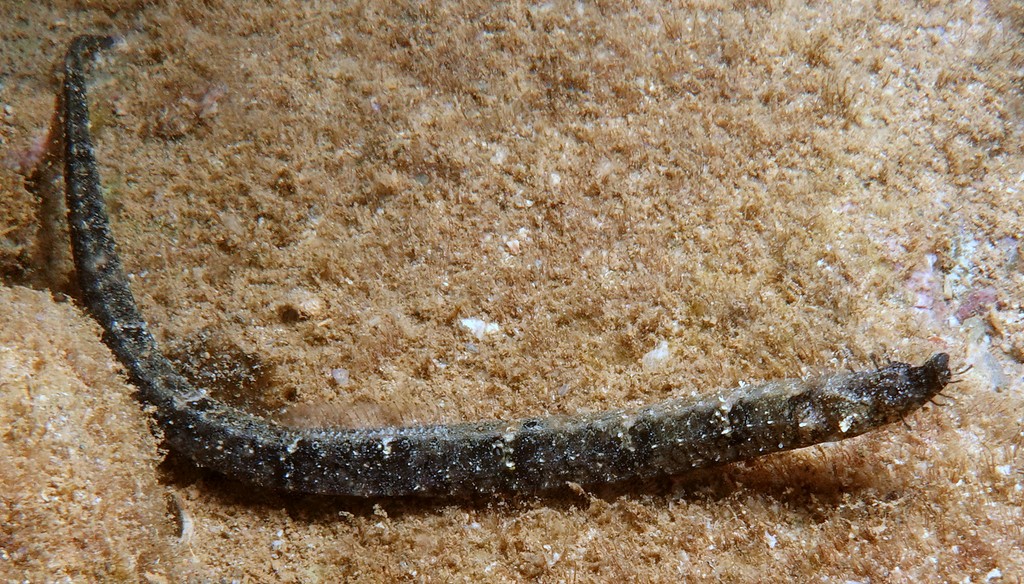HALICAMPUS BOOTHAE - (WHITLEY, 1964)
Picture courtesy of: Yves Thévenet
Actinopterygii (Gigaclass) > Actinopteri (Class) > Teleostei (Subclass) > Syngnathiformes (Order) > Syngnathoidei (Suborder) > Syngnathidae (Family) > Syngnathinae (Subfamily) > Halicampus (Genus)
Booth's pipefish, Hosoumi Yakko, ホソウミヤッコ, 띠거물가시치, 隆吻海蠋魚,
Synonyme
Micrognathus boothae (Whitley, 1964)
-----------------------------
Description
Dorsal soft rays (total): 18-24; Anal soft rays: 3-4; Pectoral fin rays: 10-12; Trunk rings; 13-14; Tail rings: 37-42. Body elongate; Head length: 11.9-16.9 in SL; Short snout, length: 3.0-3.8 in HL; Median dorsal snout ridge continuous, arcuate, the margin often minutely spinulose; Side of snout without spines or ridges in subadults-adults; Opercular ridge vestigial or obsolete. Superior trunk and tail ridges discontinuous; Principle body ridges distinct; Inferior trunk ridge ending at anal ring; Dermal flaps usually present on eye, sometimes present elsewhere on head and body. Pectoral fin base not clearly protruding laterad, usually without distinct ridges. Max. length: 17.5 cm SL. Depth range: 1 - 30 m.
Color
Color varies from light tan to dark brown; Tip of snout usually pale; Evenly spaced pale bars on dorsum and upper part of side; Often with indications of dark bars on the underside of each trunk ring.
Etymology
Halicampus: from Greek, halio-, hali- = salt, from the sea + from Greek, kampế = curvature, sinuosity or from Greek, kámpos = marine monster, sea animal.
boothae: in honor of sea turtle naturalist Julie Booth, who collected and presented type and “many interesting fishes” to the Australian Museum from New South Wales and Lord Howe Island.
Original description: Micrognathus boothae Whitley, 1964 - Type locality: Lord Howe Island (Australia).
Distribution
Western Pacific: Osumi Islands (southern japan); Eastern Australia, Coral Sea and New Caledonia.
Biology
Inhabits rich algal growth on coral and rocky reefs. Benthic species. Ovoviviparous. Eggs are brooded by males in a semi-exposed pouch under the trunk; Males may begin brooding at 9.4 cm SL. Brood size is likely to be around 120 eggs, and the larvae are morphologically similar to the adults at birth.
Similar species
Halicampus dunckeri (Chabanaud, 1929) - Reported from New Caledonia. Halicampus dunckeri is most similar to Halicampus boothae but has lower numbers of tail rings (31-36 versus 37-42) and attains a smaller size (12.0 cm in SL versus at least 17.5 cm in SL in Halicampus boothae).
Last update: 23, june 2023
Actinopterygii (Gigaclass) > Actinopteri (Class) > Teleostei (Subclass) > Syngnathiformes (Order) > Syngnathoidei (Suborder) > Syngnathidae (Family) > Syngnathinae (Subfamily) > Halicampus (Genus)
Booth's pipefish, Hosoumi Yakko, ホソウミヤッコ, 띠거물가시치, 隆吻海蠋魚,
Synonyme
Micrognathus boothae (Whitley, 1964)
-----------------------------
Description
Dorsal soft rays (total): 18-24; Anal soft rays: 3-4; Pectoral fin rays: 10-12; Trunk rings; 13-14; Tail rings: 37-42. Body elongate; Head length: 11.9-16.9 in SL; Short snout, length: 3.0-3.8 in HL; Median dorsal snout ridge continuous, arcuate, the margin often minutely spinulose; Side of snout without spines or ridges in subadults-adults; Opercular ridge vestigial or obsolete. Superior trunk and tail ridges discontinuous; Principle body ridges distinct; Inferior trunk ridge ending at anal ring; Dermal flaps usually present on eye, sometimes present elsewhere on head and body. Pectoral fin base not clearly protruding laterad, usually without distinct ridges. Max. length: 17.5 cm SL. Depth range: 1 - 30 m.
Color
Color varies from light tan to dark brown; Tip of snout usually pale; Evenly spaced pale bars on dorsum and upper part of side; Often with indications of dark bars on the underside of each trunk ring.
Etymology
Halicampus: from Greek, halio-, hali- = salt, from the sea + from Greek, kampế = curvature, sinuosity or from Greek, kámpos = marine monster, sea animal.
boothae: in honor of sea turtle naturalist Julie Booth, who collected and presented type and “many interesting fishes” to the Australian Museum from New South Wales and Lord Howe Island.
Original description: Micrognathus boothae Whitley, 1964 - Type locality: Lord Howe Island (Australia).
Distribution
Western Pacific: Osumi Islands (southern japan); Eastern Australia, Coral Sea and New Caledonia.
Biology
Inhabits rich algal growth on coral and rocky reefs. Benthic species. Ovoviviparous. Eggs are brooded by males in a semi-exposed pouch under the trunk; Males may begin brooding at 9.4 cm SL. Brood size is likely to be around 120 eggs, and the larvae are morphologically similar to the adults at birth.
Similar species
Halicampus dunckeri (Chabanaud, 1929) - Reported from New Caledonia. Halicampus dunckeri is most similar to Halicampus boothae but has lower numbers of tail rings (31-36 versus 37-42) and attains a smaller size (12.0 cm in SL versus at least 17.5 cm in SL in Halicampus boothae).
Last update: 23, june 2023
